Naturally Occurring Cultural Districts
What happens when cultural uses cluster and creative practitioners collaborate in the service of their neighborhoods.
We are celebrating 15 years — and counting — of stories that are deeply researched and deeply felt, that build a historical record of what the city has been.
In 2010, Tamara Greenfield and Caron Atlas introduced UO readers to the concept of a Naturally Occurring Cultural District (NOCD), an urban area where creative individuals and organizations tend to cluster. The case in point for that conversation was Fourth Arts Block (FAB), an East Village enclave chock full of performing arts spaces and venues. FAB owes its density of cultural activity not to top-down policies or large institutions’ capital projects, but instead to the overlapping historical influences of “immigration, labor organizing, urban renewal and… the resourcefulness of New York’s artists.” Even though FAB is the only officially recognized cultural district in Manhattan (and one of two in the whole city alongside the BAM Cultural District), it is far from the only NOCD in New York City. From Westchester Square to East Williamsburg, those neighborhoods where cultural vitality seeps from the sidewalks can be found in each of the boroughs. For the past couple years, Greenfield and Atlas have co-led a collaborative effort to convene artists, activists, creative manufacturers, non-profit organizations, and policymakers in an arts-and-culture-led research, advocacy, and awareness campaign to generate a “sustained commitment and citywide platform for revitalizing New York City from the neighborhood up.”
To date, the NOCD Working Group has produced compelling research, convened stimulating roundtable conversations, hosted informative neighborhood tours, and begun advocacy to encourage policies supportive of local cultural economies. These efforts have gone a long way towards fostering understanding from planners and policymakers about how the arts intersect with other sectors of a city’s civic and economic life. And they have helped local cultural practitioners to share resources and best practices in a climate where intensifying real estate pressure and diminishing financial support are constant challenges. But one of the things that make NOCDs such an interesting urban phenomenon is that they are not immediately recognizable. When you walk into a cultural district that is not defined by a large, visible institution (such as Lincoln Center) or obvious arts-related commerce (such as in Chelsea), you might not find much to distinguish the streetlife from that of any other of New York’s diverse neighborhoods. And while the term NOCD is meant to classify a particular district ecology, each one is unique. With this in mind, Urban Omnibus has partnered with the NOCD Working Group to look more deeply into just a few of New York’s NOCDs. Over the next several months, we will publish four original articles that illuminate the specific constellations of social forces, strategies, organizations, and individuals that make Corona, Fort Greene, St. George, and Hunts Point emblematic, each in its own way, of what can happen when cultural uses cluster and creative practitioners collaborate in the service of their neighborhoods.
The first article in the series profiles Corona, Queens, where a robust network of local groups combine public art, performance, cultural preservation, and social justice activism. One of the NOCD Working Group’s policy recommendations is to provide access to public spaces, and in her evocation of how Corona’s creative community manifests itself in the neighborhood, Caitlin Blanchfield reveals the story of reclaiming Corona Plaza for public use, a powerful example of putting cultural vitality and institutional partnerships to work for the benefit of the community.
–C.S.

Left: La Resistencia es Fértil stages a flash mob for V-Day, photo by Caitlin Blanchfield | Right: Dancing at a festival opening the new Corona Plaza, photo by Neshi Galindo, courtesy of the Queens Museum of Art
It’s a frigid February morning, but the crowds at Corona Plaza don’t seem to notice. In this wedge of open space trapped in the kink of Roosevelt Avenue between 104th and National Street, kids are chasing each other around folding tables or perched on planters gossiping. Parents stand sentinel. Church has just let out and the plaza is comfortably full. Waves of disembarking train riders pass through, dispersing into storefronts or down the sidewalk. Assessing the crowd, Adriana Escandón plugs her iPod into an amplifier and turns up the volume. She is here with La Resistencia es Fértil, a Queens-based group of Latina activists, to stage a flash mob demonstration on the plaza. It coincides with V-Day, an international effort to raise awareness about violence against women through public dance. “The V-Day movement is here locally in New York City, but not in Queens,” Adriana says, explaining that she wanted to tailor the message to an immigrant audience. She adds, “In Latin America, and the Caribbean, dance with lyrics is a traditional form of protest and communication for the oppressed. V-Day uses the same idea.”
Flash mobbers — Alexandra Garcia, Inti Ossio, a young woman named Ingrid, and her mother Gloria — join Adriana in a choreographed dance. Hand-drawn posters in English and Spanish are strapped to chairs and fence posts. The wind pulls at their corners and rustles a bag of heart-shaped galletas. Immediately, young girls begin to bop along, mimicking the moves. Sheepishly, the boys keep time on the plaza’s periphery. “Tomás, show them your dance moves!” an emboldened dancer shouts to her brother. The girls giggle, eat their cookies, and listen attentively as the troupe explains the motivation behind the choreography. Eventually the dancers disband and mothers and teens approach for longer conversations.
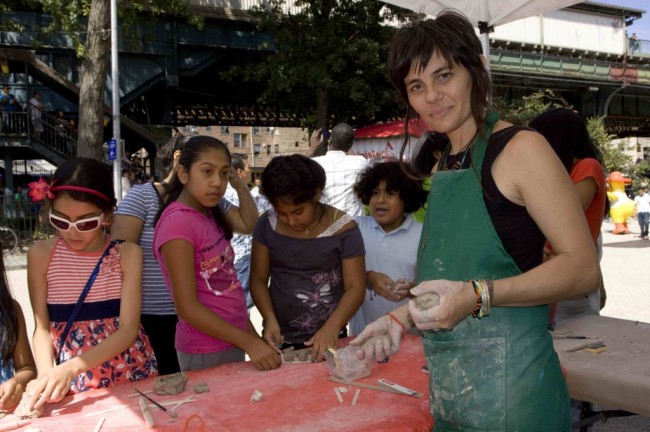
Queens Museum of Art worker at Corona Plaza | Photo by Neshi Galindo, Courtesy of the Queens Museum of Art
Corona Plaza is a gateway into the neighborhood and staging ground for community events, and its evolution reflects the informal intersections of place-based pride, traditional art practices, and an ecology of advocacy that have situated the community as a unique neighborhood in the larger context of Queens. The plaza is the collective result of many years of collaborations between different community groups in Corona, the City of New York, and the Queens Museum of Art (QMA). QMA is in the vanguard, locally and nationally, of cultural institution-led community engagement, due to its history of reaching past its walls, beyond its pastoral environs, and offering a platform to support a wide range of community-based efforts in art, cultural preservation, and advocacy. In 2007, QMA hired a community organizer with existing relationships with groups like New Immigrant Community Empowerment (NICE), Corona Action Network, the Alianza Ecuatoriana, and local leaders. “Corona people see the museum as a supporter and partner; the plaza is a space where we can do that. Corona is a vibrant and changing neighborhood, this job is about keeping one’s eyes open to what is happening in the neighborhood,” Alexandra Garcia tells me. Alexandra was the second community organizer hired by the museum and her primary project is Corona Plaza. It’s a node for the neighborhood and a window into the network of local and borough-wide groups that complement and support one another’s missions in this cultural district of Queens.
For years, a group of local business leaders took on the plaza as their project — at the time it was a triangular parking lot separating commercial storefronts from Roosevelt Avenue and the elevated tracks of the 7 train. They cleaned it up and put out the Christmas lights every year. But in an area where businesses aren’t netting high profits, organizing and funding community improvement efforts is a challenge. Roosevelt Street businesses weren’t able to cover the assessment fees needed to form a Business Improvement District — which would allow them to leverage the support of the Department of Transportation — so they reached out to a broader network of Queens organizations and public representatives. Now, through collaboration with the Queens Economic Development Corporation, these businesses are not only stakeholders, but also active participants in the shaping of public life and neighborhood pride. Alexandra points out the liquor store owner who lights the trees each winter, the restaurant that provides electricity for plaza events, and a hardware store that was an initial ally in plaza planning. The network ripples out, extending down Roosevelt and National to the many restaurants and bakeries serving up staples of Ecuadorian, Peruvian, Colombian, and Mexican cuisines.
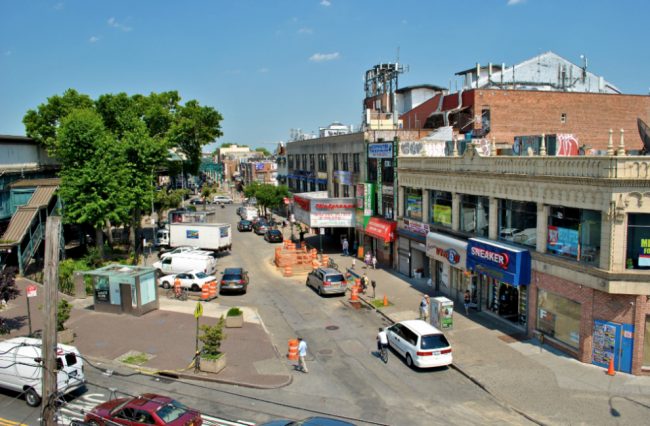
Corona Plaza before pedestrianization | Photo by Aurash Khawarzad courtesy of Change Administration
As the dancers and flash mobbers from La Resistencia chat with members of their impromptu audience, they describe themselves as a group of young women with Queens in their hearts. Corona, they say, is their community. They are the daughters of Ecuadorian and Colombian immigrants that began settling in Corona in the 1990s. At that time, this historically Italian-American neighborhood was already home to increasing numbers of Dominican families. Over the past 20 years, the demographic shift to a primarily Latino population has intensified. Now, it is a mix of Central and South Americans, and among the 138 languages spoken in Queens, Spanish is predominant here. An influx of Asian immigrants, whose borough stronghold is in neighboring Flushing and nearby Elmhurst, adds to Corona’s diversity. It’s a place of historic flux: in the 1940s and ‘50s it was home to a vibrant arts scene within the African American community, the stomping ground of musicians like Louis Armstrong, Ella Fitzgerald, and Dizzy Gillespie. In 1939, and then again in 1964, the World’s Fair was held in Flushing Meadows Corona Park, which still bears that legacy in the faded modernism of the New York State Pavilion and Unisphere fountain. The headquarters of the 1939 fair is now the site of the Queens Museum of Art (QMA).
Though massive and well used, Flushing Meadows Corona Park feels detached from the active and changing streetscapes of the adjacent neighborhood. This distance is apparent when locals talk about public space. Even within the neighborhood, the park is a destination, not a node of informal congregation; a place for planned events, not chance encounters. Perhaps the regular hours the park keeps are prohibitive, as Alexandra suggests, or maybe it’s just that different types of public spaces serve different community needs. On a cold winter day, the park isn’t bustling with the spontaneous, if fleeting, encounters apparent in the streetscape.
Back in Corona Plaza, Adriana explains, “This is the only place locally that is spacious enough and where there aren’t cars passing through. We don’t have many open spaces in Corona.” Indeed the plaza was the first place the group thought of for a public demonstration. And as they, numb fingered, begin to pack up, they are abuzz with ideas for spring workshops.
Food and dance, it seems, are touchstones of cultural life in Corona, and festivals around healthy eating and traditional dance are to be held both here in the plaza and in Flushing Meadows Corona Park in the spring, coordinated by Corona Action Network and Alianza Ecuatoriana. “The plaza has always been the place where groups meet,” Alexandra says, “the project now is to support these organizations, grow them, and allow them to extend their reach.” The ongoing transformation of this public space reflects the evolving nature of community needs, a dynamic that QMA aims to elucidate and communicate through workshops planned for this spring assessing how various players — from commuter, to stroller, to demonstrator — will use the space.
So far, the Department of Transportation has given the plaza its standard treatment: the same lexicon of urban design and landscaping written on pop-up public spaces from Times Square to the Putnam Triangle in Bed-Stuy. Roosevelt Service Road has been paved over and partitioned with granite blocks. The asphalt is now covered in a taupe wash, replete with DOT-issue planters and bistro tables in lime green and fire-engine red. But the design process won’t stop there. Because community groups, local businesses, and local cultural institutions like the Queens Museum have been activating and improving this space for years, they have been able to leverage a bit more agency on the design side, in an ongoing effort to create a public space that addresses the needs of its users. In a neighborhood where performance and demonstration are integrated into civic life, the space must be adaptable as stage, meeting room, or just place to relax.
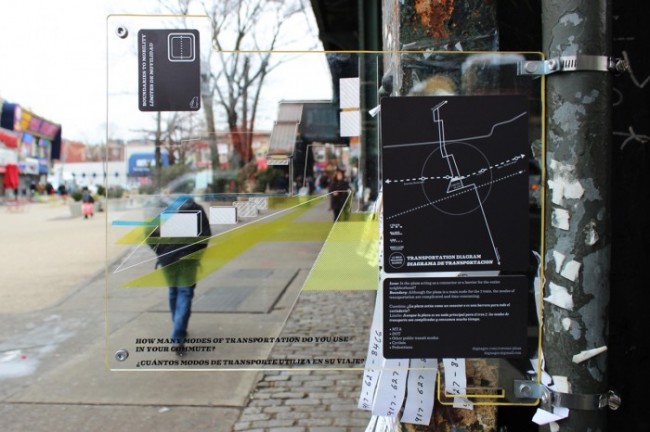
DSGN AGNC’s plaques around Corona Plaza | Image courtesy of DSGN AGNC
On trees and lampposts surrounding the plaza are anchored rectangles of plexiglass etched with sophisticated renderings of the boundary conditions around the plaza and questions about usage and access, both physical and cultural/political. These plaques are inscribed with statements such as: “Issue: What parts of the plaza are underutilized and why? Boundary: Stringent rules and costly fees keep non-commercial community groups from using the plaza,” in both English and Spanish. The plaques pique the interest of passers-by, many of whom stop to read before they carry on. The intention is to generate conversation, and according to Quilian Riano, founder and principal of DSGN AGNC, the design firm working with the Queens Museum and DOT on the plaza, it’s working well. He recounts a man bemoaning the lack of bike racks and bike lanes down nearby streets. Though the 7 line runs through Corona, north/south transportation is minimal, with only one bus route. This Saturday, March 16th, Riano plans to hold the first meeting for a co-op of community groups in Corona about the plaza, and issues like that are what he hopes to discuss. Social services, community programming, green space, local economy, and transportation and mobility will be broached through a large scale simulation game where groups negotiate their needs by jockeying about the plaza with 4’ x 4’ movable blocks. “It’s engineered to show that public space is not about everyone getting what they want, but is about negotiation,” he says. “We want to create a set of community priorities to present to the landscape architects working for the DOT.”
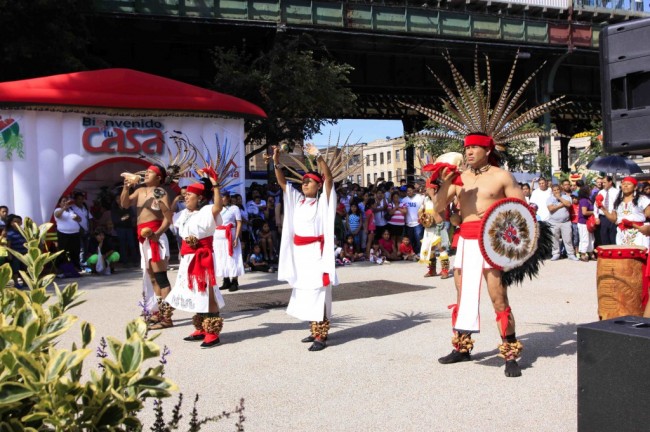
Mexica ceremony in Corona Plaza by Tenochtitlan Calpulli Tletl Papalotzin | Image by Neshi Galindo, Courtesy of the Queens Museum of Art
In Corona, space is at a premium, which is one reason that the plaza has become such a cornerstone for local community groups. The neighborhood is a patchwork of organizations that advocate national pride, identity, health, and indigenous arts. They share a constituency, from Aztec drummers to greenmarket advocates, and are allied via a network of activists with overlapping goals. Importantly, though, they operate as separate entities with separate administrations and separate workspaces. More established organizations, such as Immigrant Movement International, a project begun by artist Tania Bruguera, often serve as congregation and meeting points for smaller, neighborhood-specific groups like Alianza Ecuatoriana or Corona Action Network. But, especially over the past three years, rents have risen and Corona’s cultural organizations have found it increasingly difficult to maintain their spaces to hold classes, workshops, and meetings.
At Immigrant Movement International’s storefront space, on Roosevelt Avenue near 111th Street, Monica Aviles tells me a brief history of the Alianza Ecuatoriana. Monica, Alianza’s Culture Coordinator, is waiting for her back-up band, a group of local men who play traditional Andean drums and flutes for her Saturday morning Ecuadorian dance class. Leisurely, the band assembles and students wander in. The morning classes are for children, so their parents escort them, some staying to watch, others continuing out onto drizzly Roosevelt. In the evening, the adults come for an advanced level class. They are working towards a performance in the Andean Festival, to be held this June in Flushing Meadows. When rents were raised on the Alianza’s offices down the street and funding was cut, the ten-year-old organization was in a tough spot. Through connections made in organizing the Andean festival, Monica discovered Immigrant Movement International, which now happily hosts their classes and workshops.
Mexican, Peruvian, Bolivian, and Colombian groups practice here as well. In fact, the schedule for the space is booked back-to-back with English classes, immigrants’ rights seminars, courses on health, and dance practice. As I watch the dancers play follow the leader to the count of “uno, dos, vuelta, contravuelta,” I chat with a father to my left. His name is Jorge and he has brought both his daughter and younger brother to the class today. About three months ago, his sister came to a meeting with an immigration lawyer here, and she passed along information about the classes; now they are weekly attendees. As Monica directs the group in a box step: “derecha, al fronte, izquierda, abajo,” Jorge motions directions to Michele, his daughter. She’s at the age where right and left still present a challenge, but clearly the sky’s the limit for Michele. As class dissolves, she consults the older girls for help, who attend the evening adult class as well. Meanwhile, her father is looking at the advanced level English class schedule.
Despite the boundaries of community boards, the inscribing lines of infrastructure, or names on a map, New York neighborhoods still arise organically, products of changing population migration and enclaves for shared interests. At times this is manifest in predictable or hermetic ways: NIMBYism, or gentrification, to name a couple of undesirable outcomes. In other cases, however, mutually interested and dedicated community members breed a cultural saturation quite specific and unique. And often the physical spaces in which community is made visible, both publicly and internally, are best formed when the many forces that compose local identity can engage larger public bodies in a conversation over resources and design. Corona Plaza and Immigrant Movement International simply reflect an invisible infrastructure that connects the many people who find them useful.
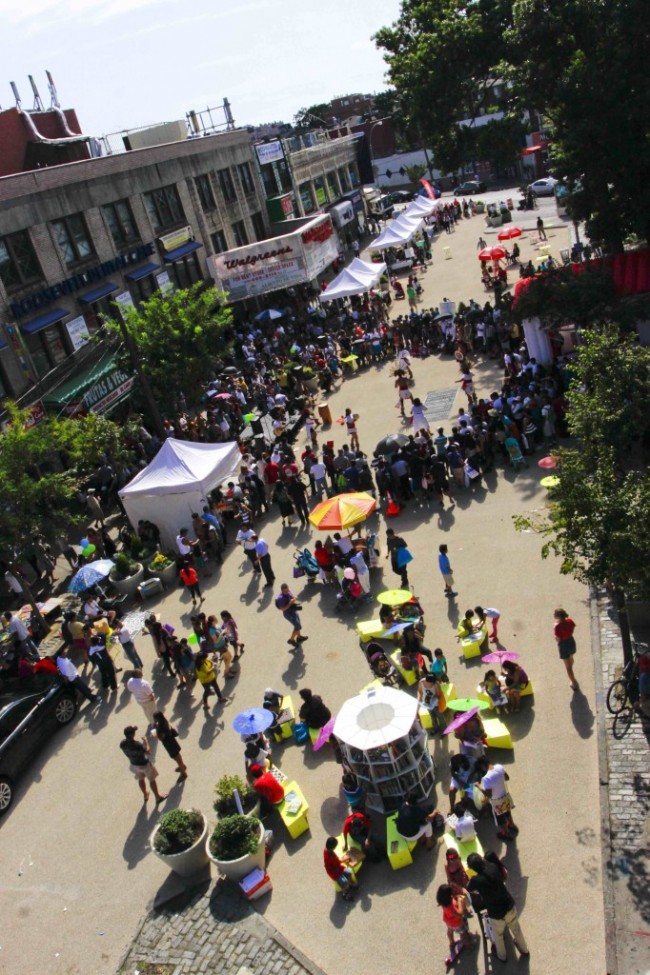
The new Corona Plaza | Image by Neshi Galindo, Courtesy of the Queens Museum of Art
The views expressed here are those of the authors only and do not reflect the position of The Architectural League of New York.
What happens when cultural uses cluster and creative practitioners collaborate in the service of their neighborhoods.
